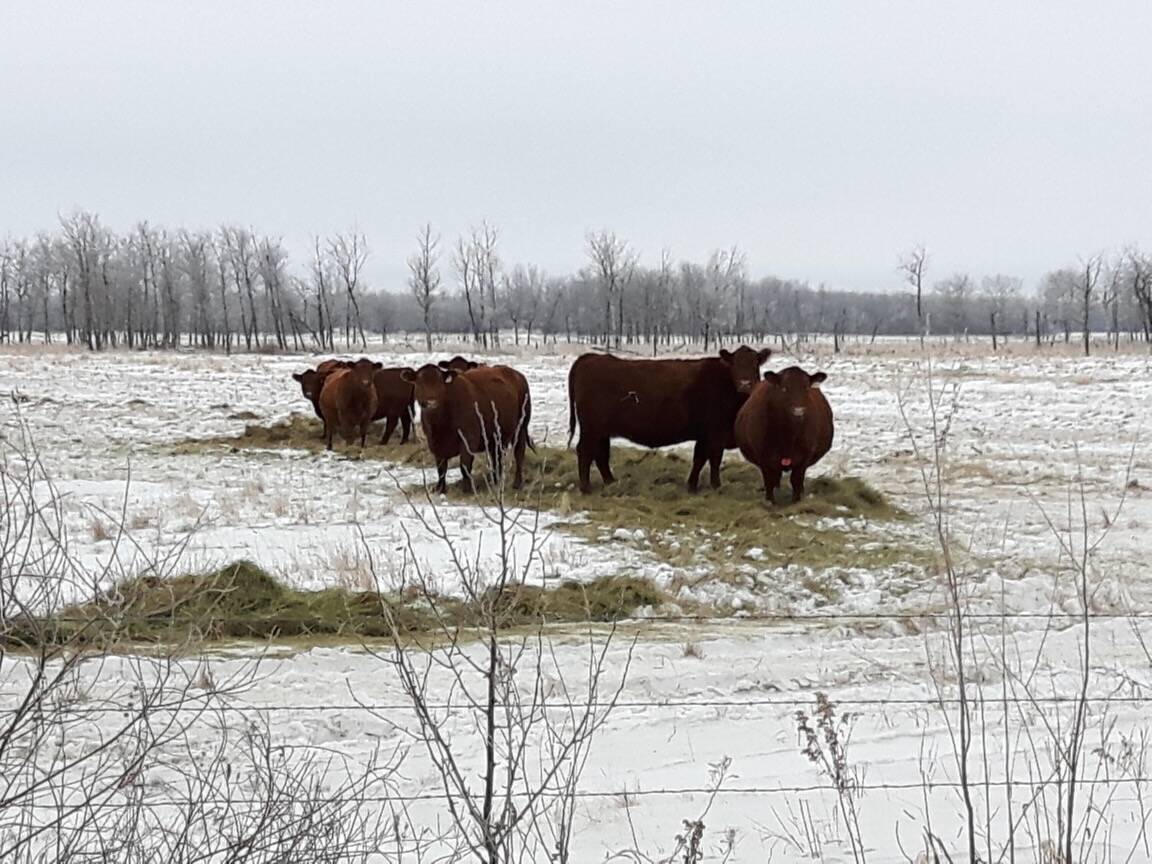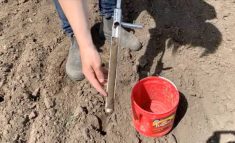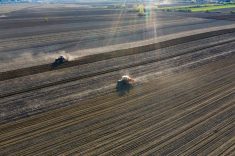In my previous Grainews article, I discussed soil phosphorus (P) cycling in soil, effects of crop rotations and fertilizing on soil P, and how crops take up soil P. In this article I’ll discuss soil tests used to estimate plant-available P. Next issue, we’ll discuss how to develop wise phosphate fertilizer recommendations for your farm.
A number of different laboratory soil tests have been developed to estimate the amount of phosphorus (P) that will become available to plants over a growing season, then to estimate the amount of phosphate fertilizer needed for optimum crop production. A soil test tries to duplicate in the lab what plant roots will have access to over several months of growing. Each soil test has its advantages and limitations.
Plants take up P from the soil solution. But the quantity of P in the soil solution is only in the range of 0.3 to three pounds per acre. Rapidly growing crops will absorb about one pound of phosphate per day per acre. Soil solution P must constantly be replenished by P from the “labile” pools of soil P. Labile inorganic P (Pi) and labile organic P (Po) are pools of soil P that are less available to plants but can undergo rapid chemical or biological changes to replenish the solution soil P that is plant available.
Read Also

Prevent nitrate poisoning in overwintering beef cows
High-nitrate feeds can be deadly for overwintering beef cows. They can be used, but only if they’re processed and diluted in a lower nitrate ration.
A soil test can’t predict with high accuracy when a crop will respond to added P fertilizer. Crop response to added P fertilizer is strongly influenced by environmental conditions, particularly soil temperature and moisture early in the growing season. For example, soil P is more plant-available in a warm moist soil versus a cool and dry soil. Also, as pointed out in my previous Grainews article, different crop types use different mechanisms to aid in taking up soil P.
Soil test methods
Almost all soil test P correlation work across Western Canada has been with zero- to six-inch sample depth. The same is true for potassium (K). Always be sure to sample the zero- to six-inch depth separately from deeper samples to accurately determine both P and K fertilizer requirements.
Various soil test P methods have been used in Western Canada to make phosphate fertilizer recommendations. Some methods work reasonably well, but others do not depending on the characteristics of the soil. The table you see here summarizes some of the P soil tests, the extractants used and the scientific reference for each method.

In the U.S., extensive field-testing in the 1950s led to the establishment of the Olsen method, also referred to as the sodium bicarbonate or “bicarb” method. The Olsen method was developed specifically for higher-pH, alkaline soils (soil pH > 7) and the extraction solution is buffered to a pH of 8.5. Therefore, this method was not intended for use on acid soils with a pH below 6.5-7. This is the recommended method in the province of Manitoba. Prior to the 1990s, the Olsen method was also the recommended method in Saskatchewan.
Research in the ’50’s and early ’60s by the University of Alberta led to the recommended use of the Miller-Axley method as the basis for P fertilizer recommendations in Alberta. This was an acid extractant that worked satisfactorily on lower-pH, acidic soils (soil pH < 7) in central and northern Alberta but worked very poorly with higher-pH soils in the Brown and Dark Brown soil zones.
The Kelowna method was developed at the B.C. Ministry of Agriculture soil testing lab in Kelowna in the mid-1980s. The method was analytically convenient and worked well to determine plant-available soil P over a broad soil pH range, which was a huge advantage.
By the early 1990s, two modified versions of the Kelowna method were developed. The Qian et al. (1994) method was developed at the University of Saskatchewan. The Ashworth and Mrazek (1995) version was developed at Norwest Labs. Acetic acid was added to the Kelowna extract by both groups to allow extraction of P and K, using one extraction solution. The concentrations of ammonium acetate and acetic acid are slightly stronger in the Ashworth and Mrazek modification. Both methods gave similar results.
In the early 1980s in Alberta, it was recognized that the Miller-Axley method performed poorly on soils with a pH above 7. In the early 1990s Alberta Agriculture led a major soil P calibration study across that province at about 450 sites to correlation P fertilizer response of wheat, barley and canola with a number of different soil test P methods. The Kelowna method — and both modified Kelowna methods — had the best correlation with P fertilizer crop response over a broad range of Alberta soils. The Kelowna method and the two derivatives of the soil test P methods were highly correlated, but there were slight differences. The two derivatives of the Kelowna method extracted slightly less P than the Kelowna method but were still very highly correlated with the Kelowna method and each other. Generally, the modified Kelowna methods will extract more soil P versus the Olsen method but preform much better over a wide soil pH range.
The two modified Kelowna methods have been Alberta’s recommended method for that province’s soils since 1994. Saskatchewan Agriculture shifted from recommending the Olsen method to the Modified Kelowna method for Saskatchewan soils. The Olsen P soil test method is recommended by Manitoba Agriculture due to the predominance of higher-pH soils in that province. The Kelowna method is the provincially recommended test to determine soil P in British Columbia.
Most of Western Canada’s soil testing labs have adopted using one of the two modifications of the Kelowna method. Most labs will also determine P by the Olsen method when requested.
Some fertilizer dealers and agronomists in Western Canada use soil testing labs in Eastern Canada or the U.S. that determine soil P using other soil test P methods such as the Bray method. This method uses unbuffered ammonium fluoride and hydrochloric acid with an extraction solution pH of 3.5. Bray and Kurtz developed the method in the 1940s specifically for acidic soils but it’s not recommended for higher pH soils (pH > 7). Because the extraction solution has a pH of 3.5, this method extracts less P at higher soil pH levels, resulting in very inaccurate plant-available soil P estimates. Because of the limitations of the Bray method, it has not been calibrated to western Canadian soils and is not recommended for making P fertilizer recommendations. If your agronomist uses the Bray method to recommend P fertilizer, be sure to ask how the test is calibrated for developing recommendations. With no calibration research in Western Canada, they are likely using Ontario or U.S. calibration data and recommendations! This is not a good 4R practice and in my opinion, you are likely not getting the best P fertilizer recommendations.
A newer method to test for a wide range of nutrients, including plant-available phosphorus is the Plant Root Simulator (PRS) probe. Developed at the University of Saskatchewan, PRS probes are ion exchange resin membranes held on plastic stakes inserted into a moist soil sample to estimate nutrient supply. There are two probes: one to adsorb cations and one to adsorb anions. A limitation of this method is that there has been less field calibration with P fertilizer research trials versus the modified Kelowna and Olsen methods, although it has been lab-calibrated to these methods.
To sum up
Remember, all soil test P correlation work across the Prairies has been with zero- to six-inch sampling depth. So, be sure to sample the zero- to six-inch depth separately from deeper samples to accurately determine P fertilizer requirements.
Alberta and Saskatchewan soil samples should be tested using the modified Kelowna method. Manitoba Agriculture recommends the Olsen method for soils in that province.
Other soil test P methods, such as the Bray method, have not been calibrated to western Canadian soils and are not recommended for making P fertilizer recommendations in Western Canada. If your advisor uses the Bray method or other uncalibrated method to recommend P fertilizer for your fields, be sure to ask how the soil test results are calibrated for developing recommendations for your farm. Odds are you are may not getting the best 4R information or the best P fertilizer recommendations.















